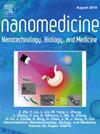抗氧化富勒醇由于其抗破骨和促骨活性而防止骨质流失
IF 4.6
2区 医学
Q2 MEDICINE, RESEARCH & EXPERIMENTAL
Nanomedicine : nanotechnology, biology, and medicine
Pub Date : 2025-07-21
DOI:10.1016/j.nano.2025.102847
引用次数: 0
摘要
目的以往的研究已经证实氧化应激在促进破骨细胞生成和骨质流失中的作用。本研究旨在评估富勒醇(一种强大的纳米抗氧化剂)预防骨质流失和促进骨生成的能力,并为其作用机制提供新的见解。方法用核因子κ b配体受体激活剂(RANKL)刺激小鼠祖细胞,在加和不加富勒醇的情况下进行破骨细胞发生实验。细胞染色检测破骨标志物的存在,RT-PCR检测破骨基因的表达。为了评估成骨作用,干细胞在含或不含富勒醇以及p38-MAPK抑制剂的成骨培养基中孵育,然后染色以确定矿化。RT-PCR检测成骨细胞基因表达。在动物模型中,家兔注射甲泼尼龙加或不加富勒醇,或对照组。随后对动物实施安乐死,并对脊柱碎片进行影像学评估。结果富勒醇能抑制RANKL作用下RAW264.7细胞中破骨细胞的形成以及破骨基因TRAP、CATK和MMP9的表达。暴露于富勒醇的D1细胞显示细胞外基质矿化和成骨基因表达增加。然而,当在p38-MAPK抑制剂的存在下加入富勒醇时,其对矿化的影响减弱。在兔类固醇性骨质疏松症模型中,同时注射富勒醇可减少椎体骨丢失,减少小梁分离,增加小梁数量。结论富勒醇具有抑制破骨细胞形成和促进成骨的作用,具有早期应用于骨质疏松症治疗的潜力。本文章由计算机程序翻译,如有差异,请以英文原文为准。

Antioxidative fullerol prevents bone loss due to its anti-osteoclastogenic and pro-osteogenic activities
Purpose
Previous studies have demonstrated a role for oxidative stress in promoting osteoclastogenesis and bone loss. This study aimed to assess the ability of fullerol, a powerful nano-antioxidant, to prevent bone loss and promote osteogenesis, and additionally provide novel insight into mechanisms of action.
Methods
Osteoclastogenesis assays were conducted in murine progenitor cells stimulated with receptor activator of nuclear factor kappa-B ligand (RANKL), with and without fullerol. The cells were stained to detect the presence of osteoclastic markers and RT-PCR was used to measure the expression of osteoclastic genes. To assess osteogenesis, stem cells were incubated in osteogenic medium with or without fullerol, as well as with an inhibitor of p38-MAPK, then stained to determine mineralization. RT-PCR was used to measure osteoblastic gene expression. In the animal model, rabbits were injected with methylprednisolone with or without fullerol, or a control. Animals were later euthanized and spine fragments underwent imaging assessment.
Results
Fullerol prevented formation of osteoclasts in RAW264.7 cells exposed to RANKL as well as the expression of osteoclastic genes TRAP, CATK, and MMP9. D1 cells exposed to fullerol displayed an increase in extracellular matrix mineralization and expression of osteoblastic genes. However, when fullerol was added in the presence of a p38-MAPK inhibitor, its effects on mineralization were attenuated. In a rabbit model of steroid-induced osteoporosis, simultaneous injection of fullerol reduced vertebral bone loss, decreased trabecular separation, and increased trabecular number.
Conclusion
Fullerol shows early potential for use in osteoporosis therapy, due to its ability to inhibit osteoclast formation and stimulate osteogenesis.
求助全文
通过发布文献求助,成功后即可免费获取论文全文。
去求助
来源期刊
CiteScore
11.10
自引率
0.00%
发文量
133
审稿时长
42 days
期刊介绍:
The mission of Nanomedicine: Nanotechnology, Biology, and Medicine (Nanomedicine: NBM) is to promote the emerging interdisciplinary field of nanomedicine.
Nanomedicine: NBM is an international, peer-reviewed journal presenting novel, significant, and interdisciplinary theoretical and experimental results related to nanoscience and nanotechnology in the life and health sciences. Content includes basic, translational, and clinical research addressing diagnosis, treatment, monitoring, prediction, and prevention of diseases.

 求助内容:
求助内容: 应助结果提醒方式:
应助结果提醒方式:


